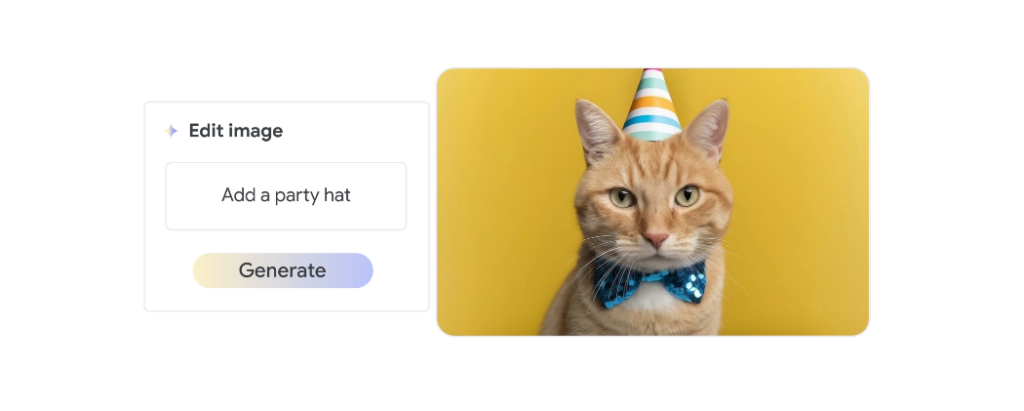Google has unveiled new AI-powered tools designed to enhance creative campaign performance for advertisers.
First mooted at Google Marketing Live in May, the new design tools enable advertisers to remove, add, and replace objects within images, offering significant creative flexibility.
These features are now available globally in English to all advertisers, with more languages coming later this year. Next month, image editing will also begin to roll out to more campaign types beyond Performance Max — including Demand Gen campaigns.
Pallavi Naresh, Google Group Product Manager, July 2024
“In June, we began rolling out new image editing capabilities to help you create more image variations and use them across different formats and sizes. These include the ability to:
- Remove objects in an image
- Add or replace objects via prompt
- Expand backgrounds
- Crop to different aspect ratios”
Generative AI capabilities, previously limited to Performance Max campaigns, have now been expanded to include App and Display campaigns. This expansion allows advertisers to generate a variety of high-quality creative assets across different campaign types, ensuring their ads are visually engaging and effective.
Seamless Integration and Workflow Improvements
Google has revamped its user interface to facilitate easier asset creation. The updated “Create” menu now includes options to generate images, create videos, and upload assets without the need to start a new campaign. This integration simplifies the workflow, enabling quicker and more efficient asset management.
Additionally, Google has formed a partnership with Typeface, a creative platform that allows advertisers to use assets created in Typeface directly within their Google Ads campaigns. This integration provides access to a wider range of design tools and templates, enhancing the creative process and ensuring that creative teams can produce high-quality assets that adhere to best practices.
Pallavi Naresh, Google Group Product Manager, July 2024
“Many of you work closely with creative teams who may do some of their best work on other platforms. Creating a large variety of assets is critical, but building them in one platform and then delivering them to Google Ads to use in your campaigns can be tedious. That’s why we’ve partnered with creative platforms to make creating and uploading assets seamless. Earlier this year, we announced partnerships with creative platforms like Canva, Smartly, and Pencil.
Typeface will now be joining the fold. Typeface’s integration with the Google Ads API lets you implement assets built with Typeface into your campaigns. Typeface also provides templates for creating images and text to use in Performance Max campaigns. This helps your creative team follow best practices for your campaign so you can achieve better results and scale.”
Enhanced Reporting Capabilities
To complement the new creative tools, Google has introduced asset-level conversion reporting. This feature allows advertisers to access detailed conversion metrics for individual assets within their Performance Max campaigns. By identifying which creative assets are driving the most conversions, advertisers can adjust their strategies to optimise campaign performance and allocate resources more effectively.
YouTube video placement reporting is another notable addition. This feature provides transparency into where video ads are displayed on YouTube, giving advertisers greater control over their ad placements and allowing for more informed decisions to maximise reach and engagement.
Third-party verification has also been implemented to ensure brand safety. Advertisers can use third-party measurement options to verify the suitability of their video and display ad placements on YouTube and the Display Network. This added layer of security helps maintain brand integrity by ensuring ads are shown in appropriate contexts.
Maximising Asset Variety for Success
Variety in creative assets is crucial for maximising the success of AI-powered campaigns. The new tools and features allow advertisers to build a broader range of creative assets to meet the diverse needs of their target audiences. By leveraging AI-powered image editing, generative capabilities, and seamless integration with creative platforms, advertisers can ensure their ads appear in the most relevant places and resonate with different customer segments.
The introduction of asset-level conversion reporting is particularly valuable for understanding what works and what doesn’t. Advertisers can use this data to optimise their creative mix and achieve excellent ad strength. Furthermore, the expanded generative AI capabilities across various campaign types, such as App and Display, provide new opportunities for creative innovation and performance enhancement.
Integrating these new features into advertising workflows may come with a learning curve. However, the potential benefits include a more streamlined creative process, better performance insights, and enhanced brand safety measures.




RECOMMENDED FOR YOU
LinkedIn Streamlines B2B Influencer Marketing
LinkedIn has introduced a more intuitive way for brands…
LinkedIn has introduced a more intuitive way for brands…
Meta Adds New AI Tools To Supercharge Lead Gen
Meta is rolling out a wave of updates to…
Meta is rolling out a wave of updates to…
Meta Announces Business AIs For Brand Websites
Meta is moving further into the AI assistant space…
Meta is moving further into the AI assistant space…